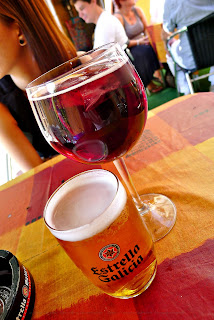If you are staying in Madrid, it is possible to do day trip to Segovia. Segovia is one of the nine provinces that make up the autonomous community of Castile and Leon. Segovia's history was first recorded to be originated as Celtic possession which eventually came under Roman rule as one of the many Latin convents. Segovia was subsequently abandoned after Islamic invasion, until the arrival of Christians. In 1985, the old city of Segovia and the Roman Aqueduct was declared UNESCO World Heritage sites.
Getting to Segovia is easy and cheap with just a 25-minutes train ride on the Renfe AVE high-speed train that departs hourly from Madrid-Charmartin Station to Segovia-Guiomar Station. Booking of Renfe tickets are usually cheaper on the internet, however, you need to understand some Spanish to navigate the site properly. The timing on the tickets are fixed and not changeable. Security screening of luggages and bags are required at every Renfe station, so make sure you arrive early.
Upon arrival at Segovia-Guiomar Station, exit the station and you will find the bus stop. There are 2 bus services available. Take bus number 11 to get to Aqueduct; the other goes in to the town centre. The bus ride cost no more than a Euro per person.
The Roman Aqueduct is one of the most significant and important Roman construction in Spain. The construction began around the 1st century. Today, the Roman Aqueduct is one of the most well-preserved monument on the Iberian Peninsula.
The Roman Aqueduct was intended to transport water from the Fuente Fria river, 17km away. The water was cleaned as it ran through the Aqueduct. The topmost layer is where the water was transported.
The Aqueduct was constructed from unmortared, brick-like granite blocks.
The roundabout where the bus will stop.
The patron saint of Segovia.
The other side of the Segovia is where the tourist office and free map can be found.
Simply follow the crowd to naviagte your way to the Cathedral.
The Cathedral of Segovia is the last Gothic Cathedral built in Spain. It is a Roman Catholic church dedicated to Virgin Mary. The architecture is considered a masterpiece of Basque-Castilian Gothic. The cathedral was consecrated in 1768 which housed a total of 18 chapels within.
The Alcazar of Segovia, a royal Palace for the Castilian kings. The Alcazar was originally built as a fortress, but subsequently became a Palace which houses a state prison, Artillery and military academy.
As the heat of the sun reaches its peak, it is time to follow the locals and enjoy siesta. We found ourselves at one of the restaurants at an alley and a seat under a sheltered canopy. Ice cold Sangria and beer are must-haves. One of the local must-have food is the roast pork.
It is not like I have never had roast pork back home, but the ones here are leaner.
A toast with duck meat cost no more than 5 Euros.
To view all the pictures of Segovia, visit Complete Segovia Album here: http://tinyurl.com/683gval
Photography by WiFi
©2011 a day in the life of a bearbrick




















































Comments